Las Vegas Business Press honors the area’s most eco-friendly companies

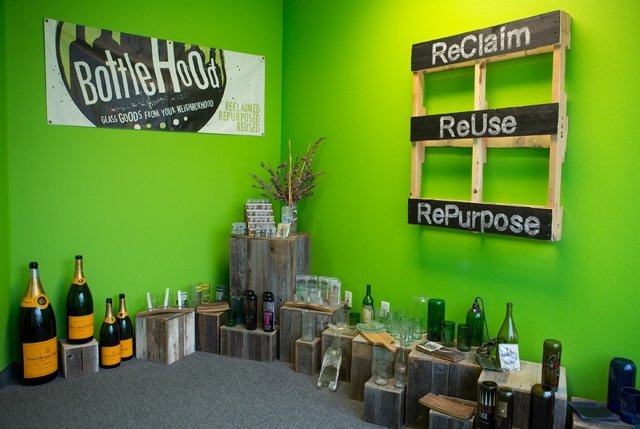

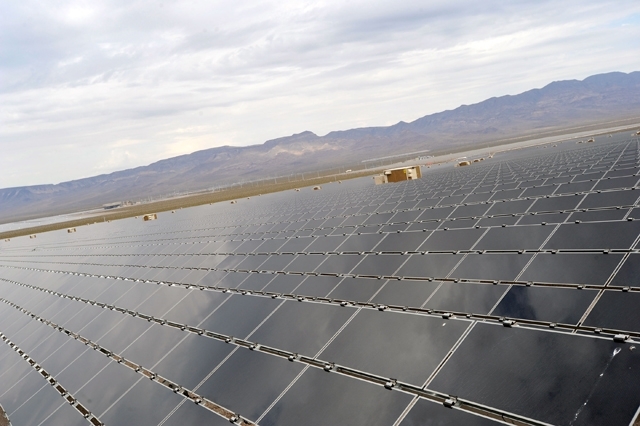
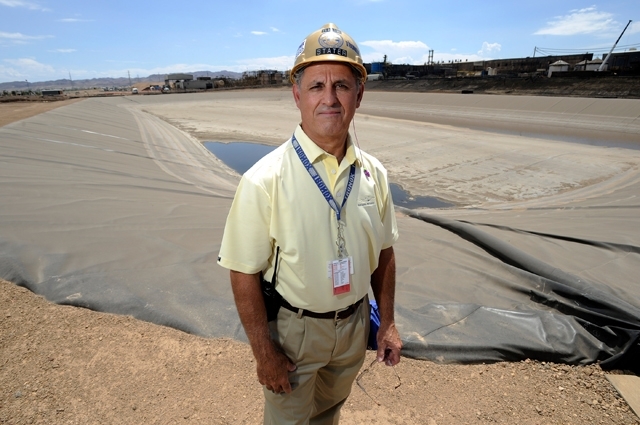

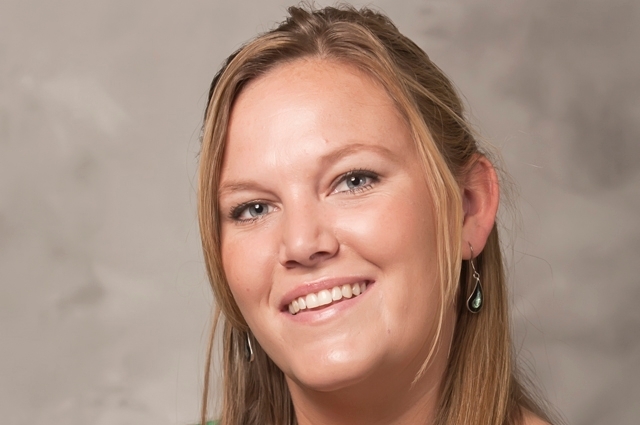

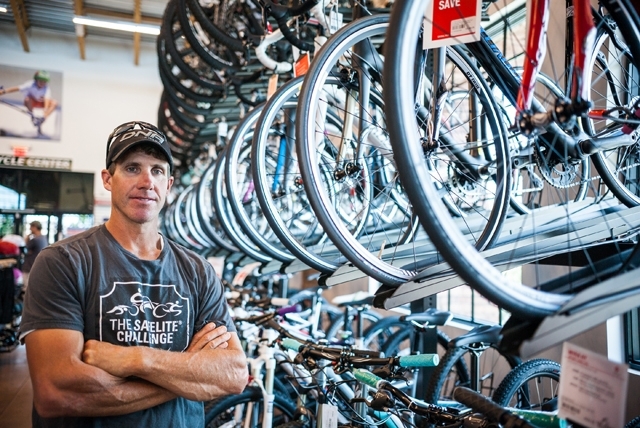
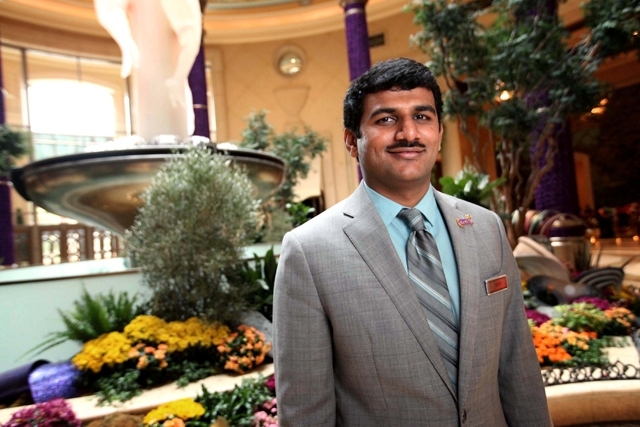
It may not be easy being green, but that’s not stopping legions of local businesses from trying to leave a smaller ecological footprint.
Business Press staffers sifted through more than 50 nominations to choose the nine winners in our latest annual installment of our Green Awards. The depth and variety of choices proved once again that green-based industries play a vital role not just in helping the environment, but also in diversifying the local economy.
From the company that transforms Champagne bottles into glasses to the megaresort operator that goes all out to get employees on board with green practices, our honorees show you how the Las Vegas Valley is a hotbed of green-related creativity.
And from one of the country’s largest solar arrays to a small business that found a way to go zero energy, they prove Southern Nevada still has its place on the cutting edge of green power.
Plus, local companies are doing their part to keep goods out of the local landfill, recycling or reusing everything from food scraps and plastic room keys to paper and tires.
There’s also an advocacy group that guides green dreams through a maze of state policies to make them reality. There’s even a nonprofit organization that takes the green gospel to local schools, where it educates tomorrow’s leaders and consumers and ensures green-centered innovation for years to come.
On top of celebrating their accomplishments, we asked our winners to share a few inspirational thoughts on why going green is both right for business, and just plain right.
— JENNIFER ROBISON
Best Green Practices, Products
BottleHood
You know that bottle of vodka you and your pals emptied while clubbing last night?
If it ended up in the hands of BottleHood, it’s probably being converted into a tumbler glass as you read this.
“I think the fact that we are the only company that can take a bottle that you drank last night from say, Caesar s Palace, and then repurpose that into a tumbler glass that you can take home with you is pretty unique,” said Jennifer Jordan, national sales manager for BottleHood.
A collection of creative environmentally conscious recyclers, or “repurposers,” started their venture in San Diego in 2009 and expanded to Las Vegas two years ago. BottleHood is in the process of moving its entire plant operation to Southern Nevada.
And why not? The company collects more than a quarter-million liquor, wine and beer bottles from 10 of Las Vegas’ largest resorts and repurposes them into, as Jordan explained, innovative creations, such as tumblers and jewelry. BottleHood even opened a retail store in Caesars Palace and ships its products all over the nation.
“In late 2011, we noticed that there was a strong need for eco-products in Las Vegas,” Jordan said. “Our business concept and model works perfectly in this city.
“It’s an exciting time for this industry right now and more than ever companies are understanding there is a new ‘P’ to your bottom line: people, profits and planet,” Jordan said.
Why is being green important?
We believe that will quickly become the norm. Just a few years ago, people did not understand the term “green,” or even, “sustainability.” Now they are common words and people understand that we have limited resources on our planet.
How can going green improve productivity?
Since sustainability is the foundation of our company, we focus on the reduce, reuse, repurpose principles from the ground up. Everything that comes into our facility from boxes, packing materials, bottles, etc., are all reused in some fashion. This greatly affects our bottom line. Since most companies first thought, for example, that if they need shelving, they go out and buy them. We repurpose palates and turn them into inventory shelves, reuse crates to store our finished products and of course our product line is based on the repurposing of bottles.
What influenced your decision to pursue green practices?
Our company was based on these practices. The company was originally founded in San Diego and moved to Las Vegas in 2011. What we didn’t realize at that time is how many other materials we could get a hold of by working with all the hotel-casinos on the Strip. We now source cork tops from used wine bottles and make products out of those as well. Our move here has inspired us to be even more innovative. We have closed our entire California operations and our company is solely based in Nevada.
How has being green reshaped your company’s public perception?
From Day One being an eco-minded, sustainable company has been our mission, so that is how the public has always viewed us. We have terrific, loyal customers, clients and partnerships.
Runners up: Aqua Element and Green Living Services Synthetic Turf Products
— ADRIENNE PACKER
Best Green Practices, Environmental
SHOWTIME TOURS
Showtime Tours is not your usual McCarran International Airport shuttle service.
Most pump conventional fuel into their vehicles.
Not Showtime Tours.
The company’s fleet of Freightliner and Ford E450 vehicles relies on biodiesel and propane fuels.
And it’s not a small fleet. Owner Lisa DeMarigny purchased 57 motorcoaches from Arizona Bus Sales.
The vehicles can use biodiesel because biodiesel does not require an engine conversion.
The propane vehicles, meanwhile, were converted using a Roush propane system.
Being green meant some investment.
To power the propane vehicles, Showtime spent $20,000 per vehicle, said Jeff Reinwald, who handles marketing and advertising for the company.
He noted biodiesel fuel also costs an additional 17 cents per gallon on average — about 8 percent higher than traditional diesel fuel. Showtime uses 140,000 gallons of the biodiesel every year.
The company also deploys GPS technology, which provides fuel-efficient routes to reduce carbon emissions.
Showtime boasts a motorcoach fleet that serves the conventions and eliminates 40 to 57 extra vehicles from driving through the condensed resort corridor each trip. That’s an overall drop of 800-1,140 vehicles per day.
Why is being green important?
At Showtime Tours, our company clean air initiative is a key component of our wellness core value. Wellness is so dear to our organization that we remained committed to using biodiesel fuel throughout the recent spike in fuel prices. We also invested in converting new vehicles to propane to further lower our fleet’s emissions. We see being green as setting a positive example which boosts team member morale and customer loyalty.
How can going green improve productivity?
Adopting green practices isn’t only good for the environment — it increases productivity within. Our employees view the extensive office and maintenance shop recycling program as a sign of a waste-free environment that encourages cooperation between workers. It makes our company more attractive to prospective team members that see long-term commitment to the health and wellness of the Las Vegas tourism market.
Who influenced your decision to pursue green practices?
Our leadership team’s commitment to our core values of wellness, innovation, integrity, relationship and profit guided our decision to pursue green practices. As the primary link in the chain between the airport and resort corridor, we felt it our duty to reduce our environmental impact.
How has being green reshaped your company’s public perception?
Showtime Tours transports more than 5,000 passengers each day. That’s more than 1.5 million passengers a year through our airport shuttle service along with an additional 1,000+ per month with our charter and motor coach division. When you move this many people, being efficient, clean and durable keeps our customers coming back and creates a positive public perception.
Runners up: Las Vegas Sands and Clark County Water Reclamation District
— ALAN SNEL
Best Green Practices, Resources
Sempra U.S. Gas & Power’s Copper Mountain Solar facility
Sempra U.S. Gas & Power develops clean power solutions in U.S. markets with a focus on zero- and low-emission fuels. The company operates solar, wind and natural gas-fueled plants that produce enough electricity for almost 1 million homes.
In Nevada, Sempra operates Copper Mountain Solar 1 and 2 in Boulder City, with the third phase under construction. The photovoltaic solar power plants do not require water to operate, preserving this resource for other uses.
The longest running part of the project, Solar 1, uses nearly 1 million solar panels spread across more than 450 acres to convert sunlight into enough renewable electricity to serve about 17,000 homes annually. The facility was built in a designated energy zone with existing power plants and transmission lines, which eliminated the need to build out additional infrastructure at the site.
In 2012, President Barack Obama toured Copper Mountain Solar 1, marking the first time a U.S. president has visited a Sempra Energy facility, with the company’s roots dating to the 1800s.
Copper Mountain Solar 2’s first solar panels are fully operational, with the rest slated to be completed by 2015. Sempra’s third Boulder City expansion, Solar 3, also is expected to be finished in 2015.
The first and second phases’ solar panels provide energy to Pacific Gas & Electric, and the third phase will provide energy to the Los Angeles Water and Power Department and Burbank, Calif., through an agreement with the Southern California Public Power Authority.
Why is being green important?
(The company) recognizes its responsibility to build and operate projects in ways that respect the environment. (It) is proud to play a role in the transition to a cleaner energy future by focusing on a low-emission energy model that includes renewable resources including solar and wind. This approach helps to preserve green resources for future generations and demonstrates that large-scale wind and solar facilities can be built and operated in a manner that supports environmental preservation.
How can going green improve productivity?
As solar panel technology evolves, fewer panels are required to produce target energy output. Installing fewer panels equates to less overall development and potential environmental impacts.
What influenced your decision to pursue green practices?
Increased consumer demand for clean energy, along with state policies mandating increased renewable power production drove the decision to focus on renewable energy development. The company, along with its strategic project partners, is currently delivering clean solar and wind power to utilities in six states including Nevada. As a longtime, established owner and operator of utility-scale energy infrastructure, the decision to pursue renewable sources of energy was a natural progression for the company.
How has being green reshaped your company’s public perception?
When Sempra U.S. Gas & Power invests in a project, it commits to becoming a long-term partner with the local community by supporting a diverse array of organizations and causes. The company takes pride in being recognized as a good community partner that is doing the right thing for the environment.
— LAURA CARROLL
Best Green Practices, Building
Tronox
You don’t often think of a chemical manufacturing plant in the same sentence as green practices.
Tronox understands that perception and the company goes to extraordinary lengths to promote and develop green building practices.
Tronox is a worldwide chemical manufacturing corporation that has long-operated a production site inside the Henderson industrial complex. The company manufactures electrolytic and specialty chemicals, many of which are found in consumer products.
Rick Stater, the manager of the Henderson plant who has worked for the facility for 30 years, said the company has shown how to eliminate negative environmental impact and develop new technologies to promote “exceptional” green building practices.
Tronox was spun off from Kerr-McGee Corp. when the company’s rocket fuel manufacturing capabilities were moved out of Nevada.
The company implemented advanced green manufacturing methods to reduce energy consumption and eliminate any disturbance to the environment.
Equipment had also been installed to recover energy from process waste streams. The recovered energy is then recycled into the plant and reduces a requirement for new energy.
Why is being green important?
In many cases, there is a reduced cost for production. Oftentimes, green products cost less to maintain.
How can going green improve productivity?
We phased out fluorescent lighting in favor of LED lights. They cost more up front, but require less energy. You don’t have to replace them as much, so there is a savings in both cost and labor.
What influenced your decision to pursue green practices?
A system was implemented years ago to eliminate 90 percent of the carbon monoxide generated by manufacturing. We started using hydroelectric power when the plant first opened. We have a water reclamation process to purify wastewater. Green practices are something we have always done.
How has being green reshaped your company’s public perception?
Chemistry is a part of everything we do. With all chemical processes, there are always issues to deal with, such as what is a less impacting way of getting rid of hazardous material. Being energy friendly sometimes doesn’t cost more money, and it also makes your business more efficient.
Runners up: Pardee Homes and the UNLV Solar Decathlon Team
— HOWARD STUTZ
Best Green Practices, Campaign
MGM Resorts International
In a city that markets itself as the epitome of excess, it might seem pointless or even contradictory for the owner of Strip resorts to take up the cause of green practices.
Indeed, many customers probably won’t care. “A group of guys coming here for a bachelor party may never know that we have recycled all their beer bottles or cans,” said Chris Brophy, MGM Resorts International’s vice president of corporate sustainability.
But a growing number of group and corporate clients in the lucrative convention and meeting market pay increasingly close attention to MGM’s effort of several years running to lighten its environmental footprint. Players in this market increasingly burnish their own green credentials by dealing with others of the same mindset, swayed by MGM’s steps in everything from trash recycling to the design and construction of the $8.5 billion CityCenter.
To drive home the importance to its employees, MGM included a sustainability message in “Inspiring the World,” a musical production that debuted last December. Produced and performed entirely by employees, the campaign went well beyond standard newsletters attached to paychecks.
More than 41,000 employees saw 12 shows at the Mandalay Bay Events Center in December, with others getting a chance to see versions of the show throughout this year.
Although the scenes about treating the environment with respect are mixed with other messages, Brophy said the focus is clear. “We can we do help the company live this value,” he said.
Why is being green important?
The fact is that the earth has finite resources. In the community and in the industry, we feel a responsibility to help steward these resources for future generations.
How can going green improve productivity?
I think about it as using resources more efficiently. We have saved 2.6 billion gallons of water over the past five years and 120 million kilowatt hours of electricity per year. At the heart of sustainability is being more productive with resources.
What influenced your decision to pursue green practices?
There is a business case for better use of resources. Beyond that, we know that we have an opportunity to be leaders not only for the company — with 52,000 employees in Las Vegas and 60,000 for all our properties — but throughout the community.
How has being green reshaped your company’s public perception?
We think we are changing more than just perceptions. We are showing that environmental responsibility and luxury lodging go hand in hand. It is not just the perception but changing the actual paradigm.
Runner up: Geotechnical & Environmental Services Inc.
— TIM O’REILEY
Best Green Nonprofit
GreenPower
Some students might not know much about history, biology or algebra, but if they study under an educator who participated in the Desert Research Institute’s GreenPower Program, they are likely well versed in issues related to the climate and environment.
GreenPower educates instructors of classes from pre-kindergarten to 12th grade about the importance of going green and the hard science that supports more sustainable methods of day-to-day living.
“The reason why we focused on educators is the idea to educate one is to educate many,” said Amelia Gulling, program manager. “Instead of trying to teach the students ourselves, we found that we could have a larger and more sustainable impact by empowering our educators, which will in turn reach more students.”
In 2010, the National Science Foundation ranked the Desert Research Institute above Harvard and Stanford when it comes to environmental research.
The nonprofit organization’s mission is to provide the tools, resources and knowledge educators need to increase students’ awareness of the environment and the importance of preserving diverse ecosystems, advancing responsible resource management and improving human health and welfare, Gulling said.
All the research and findings provided to teachers meets Next Generations Science Standards that were adopted by the Clark County School District. GreenProgram also shares opportunities for scholarships and assists educators in writing grants.
Why is being green important?
Our focus is educating our future generation about the importance of understanding our Earth’s environment and promoting preservations of our ecosystems. It is about teaching these students about technology and science that will be needed in future jobs as well. We see being green as preparing our future leaders and job-seekers.
How can going green improve productivity?
A lot of things we teach about or provide resources about all has to do with being efficient. Recycling, waste and landfills, energy efficiency and renewable energy — they are all topics of efficiency. How can we be more efficient with limited resources we currently have? We need to have students understand how our ecosystems and environments work in order to make more efficient and productive solutions in the future.
What influenced your decision to pursue green practices?
I personally grew up in a very progressive, “hippy” town in Santa Cruz, Calif. When I traveled around during my undergraduate years, this passion grew in me to create programs and systems that I had growing up. Composting and recycling were just part of my upbringing. I had a great appreciation for the environment and systems and programs that were already in place. Once I saw this was not the same (in Las Vegas), I found a passion for educating and promoting more sustainable programs.
How has being green reshaped your company’s public perception?
DRI’s main campus is in Reno and for the past 10 years the GreenPower program has been part time and just based in Reno. Having this program expand and go full time in Vegas has been great to get the word out. Many people don’t even realize that DRI is a worldwide, highly admired research facility. Nevada gets a bad rap for education, but we have one of the top-ranked institutes right in our own backyard.
Runners up: Three Square Food Bank and Create a Change Now
— ADRIENNE PACKER
Best Green Advocate
Lydia Ball, Clean Energy Project
Lydia Ball is the first executive director of the Clean Energy Project, a position she’s held since 2010.
The nonprofit organization looks at the business side of clean energy, from a technology neutral standpoint, meaning it doesn’t advocate for one method over another.
“We are here to help Nevada’s economy,” Ball said.
As the face of the project, Ball meets with community leaders and works with her board of directors to develop goals and see them through. Most recently, she lobbied the Nevada Legislature to pass Senate Bill 252, which would cut loopholes out of Nevada’s Renewable Energy Portfolio Standard. Since it passed, the bill goes to the Public Utilities Commission, which will implement regulations.
“We’re really focused on monitoring and being helpful in the interpretation of the law,” Ball said.
She’s also working on the National Clean Energy Summit, recruiting speakers and developing the message for the event.
“We kind of have our finger in everything,” Ball said.
The Clean Energy Project is funded by private foundations, donations and the Clean Energy Summit. The nonprofit organization is dedicated to powering the clean energy economy through education and engagement with policy leaders, community leaders and citizens on the economic benefits of fully developing a clean energy economy.
“My day is completely different every day,” Ball said.
When she’s not lobbying for a bill or planning a large-scale event, Ball could be found studying economic analysis on clean energy or fossil fuels, or encouraging the development of in-state resources.
Why is being green important?
I believe that it’s more efficient and it makes more business sense. And that’s the direction we need to go as humans.
How can going green improve productivity?
It depends on what you’re applying this to, but for instance, we have an office in a LEED building. It makes us happier, we have more sunlight and we’re proud of the work space we’re in.
What influenced your decision to pursue green practices?
I first started in the public policy area and I began working with the Sierra Club in 2006. I remember looking at energy as an issue. It dawned on me that we continued to have this conversation about were we going to have a green policy or support the economy. I don’t believe it’s an either-or situation. … That’s what drives me every day in being
green, because that’s what’s most effective.
How has being green reshaped your company’s public perception?
What we really like to do is sit down with businesses and pull out the Excel spreadsheet and show them how being green affects their bottom line.
Runners up: Danielle Basson and partners, Simple Environmental Services Group, and Rob Cromwell, Living EcoSmart
— LAURA CARROLL
Best Green Business Owner
Las Vegas Cyclery
Besides being a Green Awards finalist, Las Vegas Cyclery already had cause to celebrate earlier this year.
The popular bicycle store off Town Center Drive near the 215 Beltway in Summerlin was awarded a platinum Leadership in Energy and Environmental Design, or LEED, designation — the highest green rating a building can earn in energy efficiency.
The store’s owner is Jared Fisher, an accomplished mountain bicyclist who invested $2.8 million to open a state-of-the-art, 9,785-square-foot structure that generates more electricity than it uses from the local power company. Fisher financed his “net-zero” building without any public grants.
What makes Las Vegas Cyclery so energy efficient? There are 208 solar panels on the roof, one of the area’s few vertical wind turbines and occupancy-sensor, store-powered lighting. The store also conducts a popular green tour, which includes a stop at a display that measures the store’s power use.
Fisher moved his 15-year retail bike business from a Charleston Boulevard strip center in early December because that retail space was bursting at the seams with 500 bicycles. But although bicycling has a reputation for being an energy-efficient activity, Fisher said he would have built a net-zero building if he had owned a clothing store.
Fisher said he was motivated to build his green shrine to show all businesses that their buildings can be green and save energy. He also owns Escape Adventures Inc. in Las Vegas and Moab Cyclery in Utah, and runs the RTC Bike Center in downtown Las Vegas.
Why is being green important?
Mostly because human impact has surpassed earth sustainability. We need to start now and corporations are the largest contributors to environmental impact.
How can going green improve productivity?
Employees are happier to work in an environment where the air is cleaner. We keep employees twice as long on average. Employees that are healthy are happier and work harder without working longer. We have no power bill. We are able to work within the bounds our solar and wind provide our facility.
What influenced your decision to pursue green practices?
It was time for corporations to step up in the fight against climate change and overall air pollution and land degradation. The decision was easy. In fact our decision to be green was an immediate investment as our appraisal was higher than the cost of our building.
How has being green reshaped your company’s public perception?
Well, most people have always known we are a green company, but by building a net-zero LEED platinum building, it really put us in the foreground. Many people who had no idea what green really was now have a model business to base opinions.
— ALAN SNEL
Best Recycling Program (sponsored by Republic Services)
THE VENETIAN | THE PALAZZO | SANDS EXPO RECYCLING PROGRAM
Over the last few years, The Venetian and Palazzo have supported sustainable initiatives to reduce waste and eventually recycle more of what they use in an effort to cut down on what the two properties deposit in local landfills.
The Strip resorts, owned by Las Vegas Sands Corp., have implemented a number of programs, including upstream sorting and an incentive program, according to Rishi Tirupari, assistant director of sustainability at The Venetian.
“We recognize that the more diligently the dock employees work to sort recyclables, the higher our diversion rate becomes,” Tirupari said. “Knowing this, we created a program that financially incentivizes the workers to increase the diversion rate.”
The Venetian also has an extensive program that reuses or composts more than 700 tons or organic material a month, with much of the food scraps reused as feed for pigs at RC Farms in North Las Vegas. The rest gets trucked out of Las Vegas and thrown on a compost pile.
Other recycling efforts include faculty shops separating every type of material from glass to wood and metals, and the recycling of plastic room keys.
Why is being green important?
Our responsibility to the planet is as important to us as our commitment to the comfort and well-being of our guests and team members. Our legacy must be to leave a responsible, cleaner and safer world for future generations.
How can going green improve productivity?
We want our team members to feel informed, engaged and excited about sustainability, so we inspire them to both communicate our environmental values to guests and apply these values to their personal lives. In doing so, we increase team member motivation, morale and foster a greater sense of connection to the company. All of this benefits our business as well as the environment.
What influenced your decision to pursue green practices?
We have found that innovative building design and responsible construction practices minimize the immediate impact associated with the extraction, manufacturing and transportation of building materials, and provide the foundation for conservation of natural resources during the years of operation. As a developer of integrated resorts, it is important for us to embed sustainable practices in the early stages of design and throughout construction.
How has being green reshaped your company’s public perception?
Our communities are home to our properties and our team members. Increasing the understanding of sustainability through communication, awareness and partnerships within local communities is the foundation of the Sands ECO360° program. The Sands ECO360° Global Sustainability strategy is designed to help minimize our environmental impact and it reflects our vision to lead the way in sustainable building development and resort operations.
— CHRIS SIEROTY












